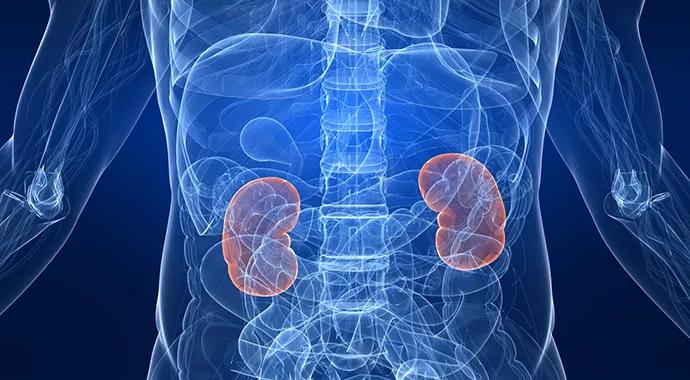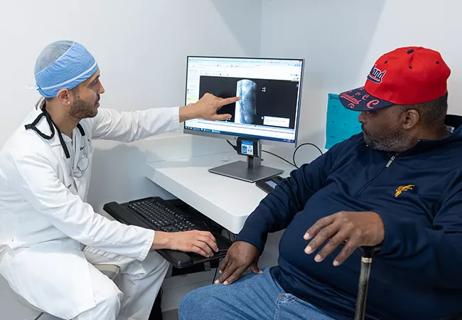Cleveland Clinic’s Endocrinology & Metabolism Institute is working to offer novel opportunities and therapies for diabetes and kidney disease

Written by Maria Luiza Caramori, MD
Advertisement
Cleveland Clinic is a non-profit academic medical center. Advertising on our site helps support our mission. We do not endorse non-Cleveland Clinic products or services. Policy
Diabetes is the single most common cause of kidney disease in the U.S. and many other countries. About 40% of patients with Type 2 diabetes develop diabetic kidney disease during their lifetime, and this proportion rises to about 50% among those with Type 1 diabetes. Chronic kidney disease (CKD) is clinically diagnosed by an estimated glomerular filtration rate (eGFR) of < 60 mL/min/1.72 m2 and/or by the presence of increased levels of urinary albumin, which is usually measured using the urine albumin-creatinine ratio (UACR). Cardiovascular disease is the main cause of death among patients with diabetes, and it is considered a competing risk when assessing the risk of endstage kidney disease among patients with diabetes.
While some of the risk factors associated with kidney disease in diabetes are known (for example, poor glycemic control, hypertension, obesity, smoking, dyslipidemia, family history of kidney and/or cardiovascular disease), others remain unknown. Unfortunately, very little is known about protective factors. Our laboratory has recently demonstrated that patients with diabetes who are protected from kidney disease have upregulation of pathways associated with DNA damage repair. DNA damage is increased in diabetes, and the ability to modulate these DNA repair pathways is associated with the risk of kidney disease.
Funded by NIH/NIDDK, our translational research has focused on studies of primary human skin (skin fibroblasts) and kidney (proximal tubular epithelial cells) cells in culture to better understand these mechanisms and determine whether augmenting the activity of these restorative pathways can protect against kidney disease in patients with diabetes. Other large NIH-funded initiatives are also underway, including the Kidney Precision Medicine Project, for which I am the co-principal investigator on grant at the University of Minnesota and the co-chair of the Clinical Operation Committee for the whole consortia, which includes all funded sites. Cleveland Clinic is one of the study sites for this large NIH/NIDDK consortia that aims to better tailor treatments to each patient.
Advertisement
Over the past few years, multiple randomized clinical trials (RCTs) have demonstrated that novel agents reduce renal and cardiovascular events among patients with diabetes. These novel agents include sodium-glucose co-transporter 2 inhibitors (SGLT2i), glucagon-like peptide-1 receptor agonists (GLP1-RA), and a novel, selective, nonsteroidal mineralocorticoid receptor antagonist (MRA). Multiple guidelines now recommend the use of these agents for renal and cardio protection in patients with diabetes, including the American Diabetes Association (ADA) guidelines and the Kidney Disease: Improving Global Outcomes (KDIGO) guidelines, which I was involved with.
An ADA-KDIGO consensus document was simultaneously published in Diabetes Care and Kidney International this past October. This document aligns the two sets of guidelines. Statements include:
Prior to prescribing these agents, it is important to familiarize ourselves with the indications and contraindications of specific agents as well as their safety profiles.
Advertisement
It remains to be determined whether the combined use of multiple novel agents will lead to an even lower risk of disease progression. Cleveland Clinic will be participating in two important trials aiming to answer this question. The first, an RCT sponsored by Bayer Pharmaceuticals (NCT05254002), is testing whether the association of an SGLT2i (empagliflozin) with a selective nonsteroidal MRA (finerenone) is more effective than either agent alone in reducing albuminuria in patients with Type 2 diabetes and CKD. The other RCT, sponsored by Boehringer Ingelheim (NCT05182840), is testing whether a new aldosterone synthase inhibitor (BI 690517) alone or in combination with an SGLT2i (empagliflozin) is associated with changes in UACR in patients with CKD, with or without diabetes.
While there is a lot of excitement surrounding the discovery of these novel agents, there is still work that needs to be done. Screening for CKD, for example, is one of the areas that needs substantial improvement. The ADA recommends at least an annual CKD screening among patients with diabetes. This should start at diagnosis for patients with Type 2 diabetes and after five years’ duration for patients with Type 1 diabetes. Screening of both eGFR and UACR is recommended. Despite the progress in therapy, screening for kidney disease in diabetes remains relatively low, with multiple studies indicating that while most patients with diabetes have eGFR data from the past 12 months, less than 50% of patients have measurements of urinary albumin. Without proper screening, the diagnosis of CKD and the opportunity of offering our patients medications to change their disease course can be missed.
Advertisement
Advertisement

Association revises criteria for the diagnosis and resolution of severe conditions

Less than 50% of patients with diabetes get appropriate ophthalmic screening through primary care referrals

Familiarity will enhance its accessibility for patients with diabetes

New study counters earlier findings linking drugs with eye disease

Study highlights the value of quantitative ultra-widefield angiography

Longevity in healthcare, personal experiences may provide caregivers with false sense of confidence

Maternal-fetal medicine specialists, endocrinologists and educators team up

Spinal cord stimulation can help those who are optimized for success